November 13, 2287 – As Nick and I headed to the lower level of the Memory Den, where Dr. Amari set people up in egg-shaped pods where they could live out parts of other people’s lives, I asked him a question I had been wondering about for quite a while, especially in light of my conversation with Hancock. With so many in the Commonwealth openly hostile toward the Institute, and synths in general, how was it that he was on such good terms with so many people? He said it hadn’t always been this way. He had never hidden who he was, and in a time when the real terror of synths came from them inhabiting friends and family, he had always just been Nick. That transparency – which was mostly forced by his facial appearance – had been vital in getting people to trust him.
That led me to another obvious question – if the Institute had patterned human-looking synths on real people, was there a real Nick somewhere? And if so, what happened to him? Turns out, the “real” Nick Valentine was a cop, and if I had spent more time in the city back in my day, I might have even run into him at a bar, or at a Sox game. The human Valentine had volunteered for a research study, and they had patterned his brain and used it for the synth that was now walking down the stairs with me.
A short hallway in the basement opened up into a brightly lit room, maybe 20×20, with computer equipment lining the walls and two recliners in separate metal egg-shaped pods facing the doorway. A bubble-type clear acrylic hinged cover formed the top third of each pod. At the far end of the room, checking some readings on a monitor, was a middle-aged woman in a lab coat with short, tightly-cropped black hair. She heard our steps on the red and white tiled floor, which looked like it could have been taken out of a 50’s diner, and asked us if we were ready.
“Hold on a second,” I said. Can someone explain to me what I’m supposed to be ready for? “Oh, just trying to discover the biggest scientific secret of the Commonwealth,” replied Nick.
“I think I’m going to need a little more to go on than that,” I replied.
Dr. Amari gave Nick a smirk, and explained that what we were going to be trying here was going to be extremely dangerous. Of course it was. We were going to take what was left of Kellogg’s brain, which turned out to be the hippocampus with some kind of neural interface attached to it, and mine it for data. Since this interface was designed to work with Institute technology, we’d get into Kellogg’s brain by substituting this bit of the medial temporal lobe for the same spot on a functional synth, which obviously meant Valentine.
“Is that dangerous,” I asked, perhaps naively?
“We’re talking about wiring something into his brain,” replied Amari.
“Don’t worry about me,” Nick chimed in. “I’m well past the warranty date anyway.”
Amari then explained that Nick was going to merely act as a host. His brain would have to decode the information from Kellogg’s hippocampus, but a secondary consciousness would have to be there to witness the memories as they were unlocked. We’d both be getting in the “memory loungers” together, and Amari would help steer my way through the memories. It wouldn’t be risky for me, but it might be disorienting because only a very small part of the brain would be available.
“Let’s do this,” said Nick.
As the transparent covers slowly lifted above the memory loungers, my legs started to feel weak. I wasn’t sure what I was going to experience, so I quickly pushed my way into the lounger chair before the cover was all the way up, and laid back, closing my eyes and taking some deep breaths.
I counted twelve breaths before the cover started to lower. A monitor on an arm above me sprung to life with a black and white “Please Stand By” card, filling the enclosed space with a dim light. Although the air had been stifling, and I wondered how I was going to breathe, I heard some quiet fans start spinning up somewhere, and felt fresh air entering the chamber.
A static electricity type sensation teased my hair, and got more and more intense, almost to a burning. Then the monitor started to go dim. Actually, everything started to go dim. I thought I must be passing out, but just as the blackness circled in, I saw these strange webs of light floating in front of and past me, and heard Dr. Amari’s voice in my head.
“There are a few memory fragments that I should be able to steer you toward. Let’s hope one of them has something that will help us figure out where the Institute is.”
And then the memories started. I felt like I was in a dream, everything seemed like it was happening now, but I wasn’t experiencing it so much as observing. Dr. Amari later told me that it’s not generally like this, it had something to do with Nick doing the decoding. Usually you experience things in the first person, which is what I had been expecting.
My brain is still kind of scrambled as I’m writing this, but if I’m remembering correctly, there were four or five memories that we were able to access, and I learned more about Kellogg and his life than I ever wanted to know.
The earliest memory was of Kellogg at maybe eight or nine years old. He and his mom were in a small, decrepit bedroom, and Kellogg was sitting cross legged on a bare mattress, with a number of old comic books fanned out around him. His mom was sitting on a red love seat, and a male voice raged from behind a wooden door. Kellogg’s dad. Again, I couldn’t sense any feelings here, just observe. There was obvious tension in the room, and in the background was some kind of running dialog, as if an experienced Kellogg was looking back on this moment and analyzing it. There was something about running away – away from the NCR and its rules, and guilt that he hadn’t been there for his mom, who had protected him from his dad for so long.
The memory was cut short, and I remember Amari apologizing as she searched for the next memory. More webs of light materialized, and started to weave themselves into thicker strands which formed a bridge out into the blackness. I moved forward, balancing on the strands, as that memory faded away behind me. It wasn’t long before a light up ahead started to come into focus. The strands were leading me to a room in a small apartment, where an older Kellogg was washing dishes with a woman, who turned out to be his wife. His baby daughter slept in a crib a few feet away by the kitchen table. A window revealed a view of the Golden Gate Bridge, partially enveloped in fog.
It was at that moment that I realized these memories weren’t necessarily to be taken literally. The condition of this apartment didn’t suggest it was of the caliber to have such a magnificent view. It was likely some hodgepodge of Kellogg’s memory, perhaps a thread to things of beauty that he saw at this time. His wife and child, the stunning landscape of San Francisco. The dialog continued. He had been happy, but looking back, he should have seen he deserve either of them. He didn’t deserve to be that happy. He killed people for a living. Why did he think he could have this? As the memory continued down a long hallway with pipes strapped to the walls, a different voice broke out of the silence, and if I could have felt my body, I’m sure I would have jumped.
“Just so you know, they died like dogs,” said the voice, seemingly right in my ear, “and you weren’t there to help them.”
After that, Kellogg was always on his own. In a bar, being hired for mercenary work, taking people out in an alleyway, and then in front of a woman in a uniform seated at a table with three rather primitive looking synths guarding her. He had been summoned, because some of his jobs had run afoul of the Institute’s plans. He was being told to stand down. Instead, he took out all three synths, and the woman at the table seemed surprised, and, if I read her expression right, a bit pleased. This must have been the point where he started working for the Institute.
And then, next thing I knew, I was looking at the cryogenic chambers in Vault 111, where this whole thing started. Standing in front of Nora & Shawn’s chamber was Kellogg, and two people in biosuits, probably scientists. Somehow, the running dialog this time had an awareness of what eventually happened after I arrived at Fort Hagan. It seemed as if his brain was trying to make the observer aware of the hardships he had endured, as if we weren’t all that different, he and I. If that’s what he thought, he couldn’t be more wrong. I wasn’t feeling any sympathy for him at all. I had no doubt that people had to do some horrible things to survive out here over the last 200 years, but I had to believe that there was still a way to do live without turning to killing defenseless women and stealing their kids from them.
I watched that whole horrid scene play out, from the scientists opening the chamber, to Nora struggling when they tried to pull Shawn from her, to Kellogg shooting her dead. And yet again, there was nothing I could do but watch. Kellogg walked over to my pod, looked in on me, and the dialog resumed, again with the insight into the present day. He was thinking that it was a mistake leaving me alive, that he thought he could handle some soft, pre-war vault dweller, but he should have understood this kind of revenge. He was just happy that the Institute bastards were going to get what was coming to them now. He also noted that it was the Institute that ordered everyone else in the vault NOT be re-frozen, basically entombing everyone alive. He said “the old man didn’t want any loose ends,” and too bad he left alive the one person he shouldn’t have.
Who was this old man he was talking about?
Just then, I heard Dr. Amari’s voice emerge once more. She was apologizing for making me go through that again. “I think there’s one memory left,” she said. “We have to hope this one will give us something.”
I walked across yet another light bridge to a small room with metal walls. She said this was a recent memory. I recognized it as the main room at his house in Diamond City. Kellogg was sitting in the back of the room, and just in front of his desk, seated on the floor was Shawn, perhaps eight or nine years old, with comic books spread around him. In some ways, the scene was eerily similar to the one earlier with Kellogg as a child on his bed.
I strained my eyes to see him better, but he was looking down, and I had no way to change my view. Kellogg’s voice continued, that looking back, this whole thing seemed like bait for the guy from the vault. That would be me. This really wasn’t that long ago.
Suddenly, the door opened, and a young, muscular and intimidating man said he was taking the boy to the Institute, because Kellogg was needed for a mission. A Doctor Bryan Virgil, one of the Institute scientists, had gone rogue and was hiding somewhere in the Glowing Sea. He had been working on a top secret project, and Kellogg’s orders were to find him and kill him.
I heard Shawn’s voice – “you’re taking me to my father?” “Yes,” said the man, and told Shawn to stand next to him and hold still.
A lightning bolt blasted through the darkness, and the man and Shawn were gone in that flash. Teleportation. No one had found the entrance to the Institute because there was no entrance.
I wondered if Kellogg had gotten to Dr. Virgil before I met him at Fort Hagen, or if I had interrupted him first? I remembered the cigar Dogmeat had found at the little pond just outside Diamond City and figured there was probably a good chance that I had taken care of Kellogg before he had gotten to the Doctor.
The scene went dark, and more strands assembled and led the way to a bright light. Dr. Amari explained that she was now transitioning me out of the memory, and after a minute or so, I realized I was looking, groggy-eyed, at the Please Stand By card again. The cover to the pod lifted, and the Doctor extended her hand to help me out.
While I was waking up, she had removed the implant from Nick, who I was told was upstairs. I asked her what the Glowing Sea was. Was I headed underwater?
No, she responded. The Glowing Sea wasn’t a sea at all, but a completely irradiated area in the southwest Commonwealth – ground zero for where the bomb struck in 2077. She said I’d be able to see it long before I even reached it, and it would look like a sort of luminescent fog. I had a vague recollection of seeing a glowing fog a week or so ago when I had been in the foothills above Fort Hagan, but I hadn’t realized what it was. Amari said that I’d need a biohazard suit and plenty of Rad-Away and Rad-X. I asked if a suit of power armor would do, and she said most likely it would. But I’d have to be careful for sinkholes, and she didn’t know what kinds of creatures or other mutants could be wandering around in that soup. It wasn’t a popular location. People didn’t venture there, and when they did, they usually didn’t come back.
It looked like I was going to have to go back to the Red Rocket and finally pick up that power armor. And then it was off to the Glowing Sea to find Dr. Virgil, if he was still alive.
When I met up with Nick, he was seated once again on the couch at the far end of the room by the exit. He looked up at me, and suddenly Kellogg’s voice emerged as he spoke – “Hope you got what you were looking for, inside my head. I should have killed you when you were on ice.”
“Kellogg?” I said.
“What are you talking about,” Nick’s normal voice returned.
“You sounded like Kellogg.”
Nick relayed that Amari had said there might be some of Kellogg’s impressions still lingering. I wondered how that was possible if that module had been completely removed, but I was no doctor. I sort of scanned his face, looking for anything that was out of the norm, but everything seemed to be OK.
He suggested we get going, but I quickly made a decision to undertake this part of the mission alone. He asked if I was sure, that the Glowing Sea shouldn’t be any problem for a synth, but the only way I can describe what I was feeling is that I was kind of hung over. Experiencing the murder of my wife and the kidnapping of my son in Vault 111 for a second time had really thrown me, and I felt I needed some time alone to process it.
After swinging by the Red Rocket to pick up the power armor, I’d travel to the Glowing Sea to try to find Dr. Virgil, then if I was successful, I’d return to Diamond City to pick up Nick before heading to the Institute. I was a bit apprehensive thinking about what I might find wandering around the irradiated zone in the Southwest Commonwealth, but I had come this far. I imagined it was probably almost dawn now. I’d see if I could get a couple hour’s rest somewhere in Goodneighbor, and then I’d head out at first light, taking a northern route across Boston as I made my way back to the Red Rocket.
Podcast: Play in new window | Download (Duration: 17:05 — 31.3MB)

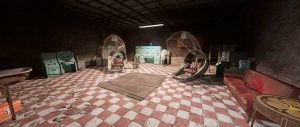
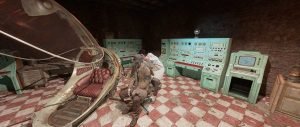
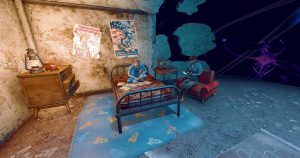
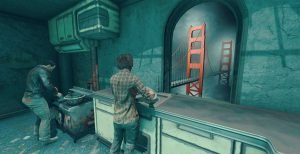
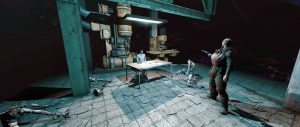
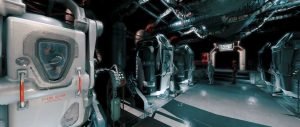
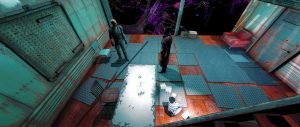
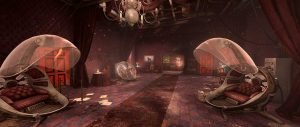
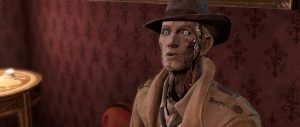

2 Comments
Lou
April 27, 2017 at 4:33 pmSpectacular as usual. Please keep them coming!
Aaron Clow
May 9, 2017 at 3:21 pmThanks, Lou! Now, if only I could stick to a schedule! ;)